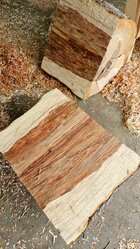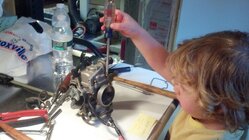A coworker gave me a few 12" tall, 15" diameter pieces of sopping wet, heavy-as-concrete apple wood this week. Yesterday I put my Hundred-Dollar-Wonder Oregon CS1500 corded electric chain saw to the ultimate test, cutting the rounds into half circles, ripping with the grain. In the end, it worked admirably. A bit slower than what my ol' Stihl Farm Boss would have done, but I did it inside my garage on a rainy day without any 2-stroke smoke to inhale. Like any chainsaw, when ripping with the grain, the bottom chip discharge quickly clogs with ribbon shavings, so literally about every 10 seconds I had to stop and pull the clog out of the chute. Takes about 1.5 seconds, pfft.
Anyway, last fall I helped my neighbor by using the saw to cut down a 6-pack clump of 6-7" diameter, 30' tall silver maple. Zip-zip-zip-zip... easy. But, I neglected to give the saw a thorough once over after that day, and yesterday it let me know by tossing off the (properly tensioned) chain. No injury to me or the chain, but it forced me to stop and examine the saw closely.
I found the chain groove of the bar, and the front sprocket area, was very gunked up with oily sawdust. And although I learned last year that chain tension must be continuously watched, and tweaked as needed, I think that bar gunk (see the paper towel mess, all from the bar chain groove) was leading to the derailment. Even the built-in round sharpening stone was caked with oily dust, I scraped it clean with a dental pick. It goes without saying (uh-huh) that any saw needs to be carefully and regularly cleaned, maintained, and adjusted, but this saw probably can't handle the, uh, deferred maintenance that a big gas Stihl, Husky, etc. can handle. It's a light weight saw with a smaller profile chain. It punches WAY above its weight class, but it needs to be treated more carefully and deliberately than the bigger gas machines. I still heartily recommend this saw for in-shop/garage and yard use. I am very pleased with it overall.
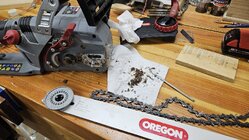
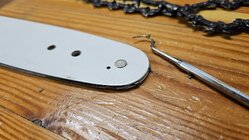
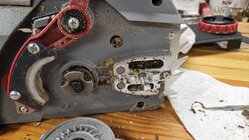
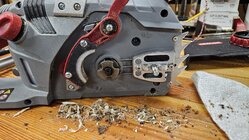
Anyway, last fall I helped my neighbor by using the saw to cut down a 6-pack clump of 6-7" diameter, 30' tall silver maple. Zip-zip-zip-zip... easy. But, I neglected to give the saw a thorough once over after that day, and yesterday it let me know by tossing off the (properly tensioned) chain. No injury to me or the chain, but it forced me to stop and examine the saw closely.
I found the chain groove of the bar, and the front sprocket area, was very gunked up with oily sawdust. And although I learned last year that chain tension must be continuously watched, and tweaked as needed, I think that bar gunk (see the paper towel mess, all from the bar chain groove) was leading to the derailment. Even the built-in round sharpening stone was caked with oily dust, I scraped it clean with a dental pick. It goes without saying (uh-huh) that any saw needs to be carefully and regularly cleaned, maintained, and adjusted, but this saw probably can't handle the, uh, deferred maintenance that a big gas Stihl, Husky, etc. can handle. It's a light weight saw with a smaller profile chain. It punches WAY above its weight class, but it needs to be treated more carefully and deliberately than the bigger gas machines. I still heartily recommend this saw for in-shop/garage and yard use. I am very pleased with it overall.





